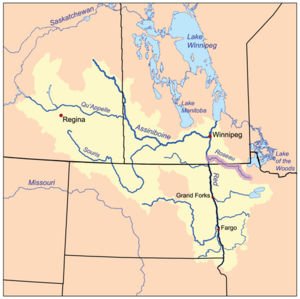Roseau River (Manitoba–Minnesota) facts for kids
The Roseau River is a river that flows through parts of Canada and the United States. It is about 214 miles (344 kilometers) long. The river starts in northwestern Minnesota and then flows into southern Manitoba.
The Roseau River is a smaller river that joins a bigger one. It flows into the Red River of the North. From there, its water eventually reaches Lake Winnipeg and then the Nelson River. Finally, the water from the Roseau River ends up in Hudson Bay.
Contents
The Roseau River: A Journey Through North America
The Roseau River is an important waterway. It connects different areas in both countries. Understanding its path helps us see how rivers link up.
Where Does the Roseau River Flow?
The Roseau River begins its journey in Minnesota. It flows through several counties there. These include Roseau County, Minnesota and Kittson County, Minnesota.
After flowing through Minnesota, the river crosses the border. It then enters Manitoba, Canada. The river continues its path through the Canadian landscape. It eventually joins the Red River of the North.
What Does "Roseau" Mean?
The name "Roseau" comes from the French language. In French, "roseau" means "reed." Reeds are tall, grass-like plants. They often grow in wet, marshy areas.
This name was inspired by the Ojibwe language. The Ojibwe people called the river "Ga-shashagunushkokawi-sibi." This means "place-of-rushes river." Rushes are similar to reeds. Both names describe the plants found along the riverbanks.
People and the Roseau River
The Roseau River has been important to people for a long time. It flows through the land of the Roseau River Anishinabe First Nation. This is an Indigenous community in Manitoba.
The river also gave its name to a community. There is a place called Roseau River in Manitoba. This shows how the river is part of the local identity.


